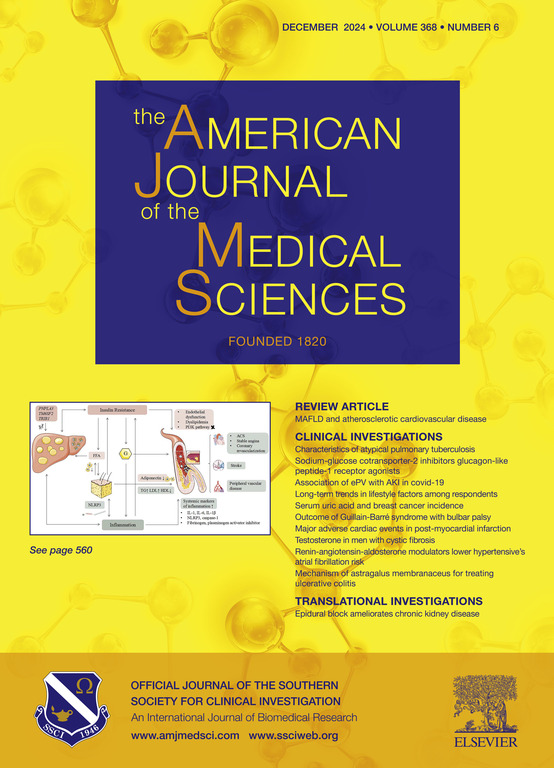体重指数正常的2型糖尿病患者心脏标志物、血浆动脉粥样硬化指数及心脏代谢指数对冠心病的预测价值
IF 1.8
4区 医学
Q2 MEDICINE, GENERAL & INTERNAL
引用次数: 0
摘要
背景:先前的研究已经确定2型糖尿病(T2DM)是冠心病(CHD)发病的危险因素。然而,脂质代谢异常对正常体重指数(BMI)人群冠心病发展的影响仍不确定。本研究旨在探讨BMI正常的T2DM患者发生冠心病的危险因素,并建立预测模型。方法:采用多因素logistic回归分析和LASSO回归分析,探讨冠心病的独立危险因素。采用校准、决策曲线分析(DCA)和精确召回率(PR)曲线来评估模型的拟合优度。结果:经logistic和LASSO回归分析,T2DM病程、FBG、HbA1c、NT-proBNP、sST2、AIP、CMI等7个独立危险因素对BMI正常的T2DM患者发生冠心病有影响。利用这些因素进行似然比检验,构建稳健可靠的正态图模型预测冠心病风险(χ2 = 309.52;P < 0.001), C指数(0.964;95% ci: 0.945 - 0.983;P < 0.001), hosmer-lemeshow拟合优度(χ2 = 3.7675; = 0.878页)。结论:我们的研究结果表明,BMI正常的T2DM患者脂质代谢受损与冠心病的发病密切相关。有效的管理策略,包括严格控制血糖、警惕监测心肌标志物、调节血脂和内脏脂肪,对于降低BMI正常的2型糖尿病患者冠心病的发病率至关重要。本文章由计算机程序翻译,如有差异,请以英文原文为准。
Predictive value of cardiac markers, atherogenic index of plasma and cardiometabolic index for coronary heart disease in type 2 diabetes mellitus patients with normal body mass index
Background
Prior research has established type 2 diabetes mellitus (T2DM) as a risk factor for the onset of coronary heart disease (CHD). Nevertheless, the impact of abnormal lipid metabolism on the development of CHD in individuals with a normal body mass index (BMI) remains uncertain. The objective of our study was to examine risk factors for CHD in T2DM patients with normal BMI and construct predictive model.
Methods
Multivariate logistic and LASSO regression analyses were utilized to examine the independent risk factors associated with CHD. A calibration, decision curve analysis (DCA), and precision-recall (PR) curves were employed to assess the model’s goodness of fit.
Results
Seven independent risk factors, namely the duration of T2DM, FBG, HbA1c, NT-proBNP, sST2, AIP, and CMI, contributed to the development of CHD in T2DM patients with normal BMI by logistic and LASSO regression analysis. These factors were utilized to construct a robust and dependable nomogram model for predicting CHD risk with the likelihood-ratio test (χ2 = 309.52; P < 0.001), C index (0.964; 95 % CI: 0.945 - 0.983; P < 0.001), and hosmer-lemeshow goodness fit (χ2 = 3.7675; P = 0.878).
Conclusions
Our findings indicated that impaired lipid metabolism in T2DM patients with a normal BMI is closely linked to the onset of CHD. Effective management strategies, including strict glycemic control, vigilant monitoring of myocardial markers, and regulation of blood lipids and visceral fat, are essential for reducing the incidence of CHD in T2DM patients with normal BMI.
求助全文
通过发布文献求助,成功后即可免费获取论文全文。
去求助
来源期刊
CiteScore
4.40
自引率
0.00%
发文量
303
审稿时长
1.5 months
期刊介绍:
The American Journal of The Medical Sciences (AJMS), founded in 1820, is the 2nd oldest medical journal in the United States. The AJMS is the official journal of the Southern Society for Clinical Investigation (SSCI). The SSCI is dedicated to the advancement of medical research and the exchange of knowledge, information and ideas. Its members are committed to mentoring future generations of medical investigators and promoting careers in academic medicine. The AJMS publishes, on a monthly basis, peer-reviewed articles in the field of internal medicine and its subspecialties, which include:
Original clinical and basic science investigations
Review articles
Online Images in the Medical Sciences
Special Features Include:
Patient-Centered Focused Reviews
History of Medicine
The Science of Medical Education.

 求助内容:
求助内容: 应助结果提醒方式:
应助结果提醒方式:


